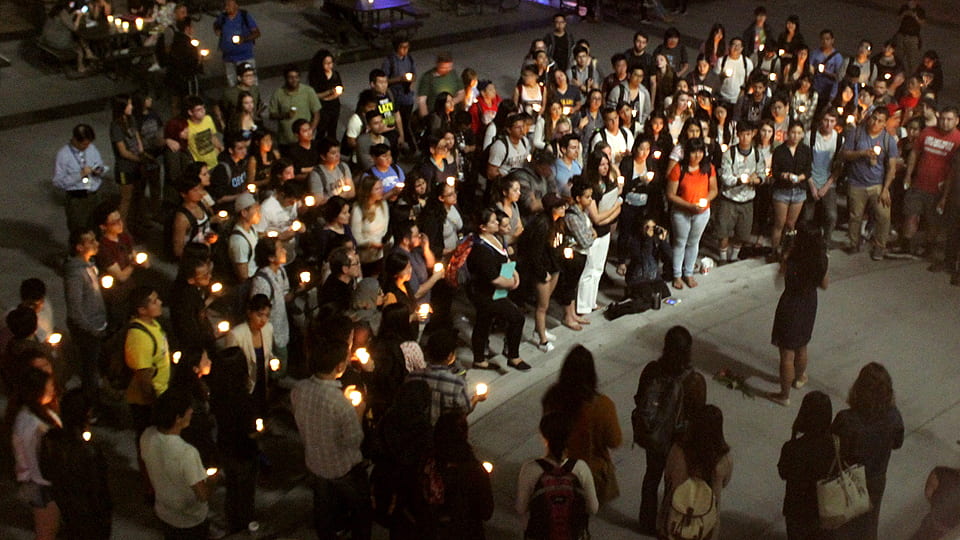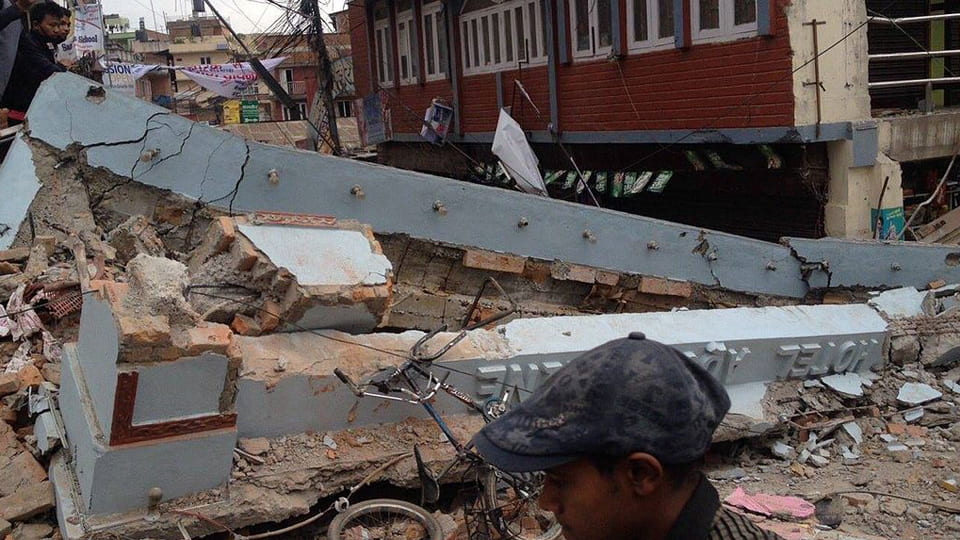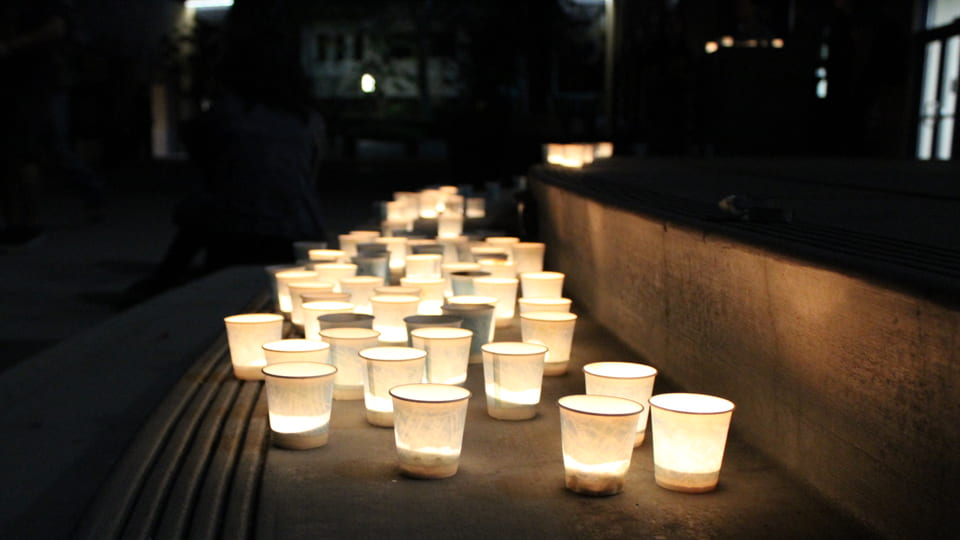Shaking up the future
UCI grad students are investigating ways to make earthquakes less destructive
More than 300 students gathered at the UC Irvine Student Center Terrace for a candlelight vigil Wednesday to demonstrate compassion for victims of the 7.8-magnitude earthquake in Nepal. Dristi Angdembey, a senior in biological sciences who has family there, said she was overwhelmed by the support of her fellow students.
“In Nepal, our infrastructure is weak and our government can’t provide for those who are suffering, and that makes me feel hopeless,” she said. “But when I see the amount of support here for victims, I feel more hopeful.”
The outpouring is just one way UCI students are striving to make a difference. In campus labs from social sciences to engineering, research continues on ways to predict and mitigate such catastrophes. Here are two examples.
Tremors in the system
When an 8.1-magnitude earthquake and its aftershocks struck Mexico City in 1985, the collapsing structures claimed the lives of more than 10,000 people in a matter of days. In the aftermath of this natural disaster, the government began funding development of the world’s first early earthquake alert system in hopes of preventing future tragedies.
The Sistema de Alerta Sísmica launched in 1991 with 12 sensory stations strung along the country’s west coast. Now known as the Sistema de Alerta Sísmica Mexicano, it has grown to include 98 sensory stations, which detect earthquakes near their sources and issue speedy warnings, giving people in such population centers as Mexico City and Oaxaca crucial seconds to evacuate or take shelter before the tremors reach them.
SASMEX has successfully alerted Mexican people to hundreds of earthquakes since its inception, but Beth Reddy, a UCI graduate student in anthropology, suggests that this lifesaving system is not being utilized to its fullest potential. As California scientists and policymakers work to develop a similar system here in the face of significant budget and political constraints, Reddy’s final dissertation on the complexity and politics behind Mexico’s system offers valuable insight into how early alert technology can be used to prevent disaster – as well as what obstacles may present themselves along the way.
“Few people have heard of it,” she explains, “even though SASMEX is in schools and government offices, integrated into the subway systems, broadcast on some TV and radio stations, on state-owned loudspeakers, in some commercial spaces and increasingly available via personal smartphone apps.”
Many who have heard of the system, Reddy says, either don’t trust it or don’t understand the distinction between it and other, less effective alarms that sound during an earthquake.
“Those are very different kinds of things,” she says, “and they should mean very different kinds of safety-oriented actions.”
The quality and timeliness of her dissertation research has caught the attention of multiple foundations, earning Reddy more than $30,000 in fellowships, including awards from the University of California Institute for Mexico & the United States and National Science Foundation.
Reddy used findings from her surveys and observations in Mexico City to examine the complex relationships among science, technology and government, focusing on what she calls Mexico’s seismic politics. She ultimately found that public safety in Mexico is usually approached from a technical perspective and that the background political and social work that scientists and engineers conduct to make this technical work relevant is not highlighted as an essential element of disaster prevention. Reddy believes that the “social part” of technical labor has serious implications in terms of how policymakers and ordinary people understand and use – or fail to use – this system.
“SASMEX is, technically speaking, a great tool and only getting better as its scope grows,” she explains. “In the past few years, the size of its network has expanded … [and] the collection of sensory field stations now spans much of the center and southern parts of the nation, which means the system has a radically increased ability to register earthquakes and send out alerts. It’s still growing. However, lack of [public] uptake is troubling.”
Reddy hopes her dissertation will prompt further research on the subject so that the system will be more widely used and that more lives will be saved. As she continues her own studies, Reddy will work to encourage practical approaches to these kinds of advanced technological tools. She’s expected to complete her graduate program by June 2016.
Danger from dams and levees
Riccardo Cappa’s use of numerical simulations and models to portray the seismic response of water-diverting structures such as levees and dams won him a $10,000 Public Impact Fellowship from UCI’s Graduate Division this year.
In particular, the civil engineering doctoral student is appraising levees on the Sacramento-San Joaquin River Delta. These structures, which are made of loose dredged sand, were built on a highly compressible and easily erodible foundation, and after many years of land reclamation and farming, the interiors of most delta islands and tracts currently lie up to 5 meters below sea level.
As a consequence, a single crack in these fragile levees would easily result in the flooding of an entire island, causing considerable economic damage. A severe earthquake striking the region could cause multiple simultaneous breaks, leading to a devastating scenario.
“I hope that my research will help in recognizing the potential for a catastrophic situation and encourage legislators to discuss possible solutions,” says Cappa, who came to UCI from Italy. “The ultimate goal would be to someday help prevent a tragedy for the state, as well as develop a novel analytical framework to study regionally and globally to improve the seismic performance of levees.”
Cappa, who expects to complete his doctorate this year, earned a bachelor’s degree in architectural & building engineering at the University of Bologna and a master’s in structural engineering at UCI. He already has gained public attention with his research, presenting it to the Association of State Dam Safety Officials, the American Society of Civil Engineers, and the California Geotechnical Engineering Association. In addition, Cappa has several papers under review and published his work in last year’s Dam Safety National Conference publication.
He accompanied Frances Leslie, vice provost and dean of UCI’s Graduate Division, to a three-day April workshop in Washington, D.C., organized by the American Association for the Advancement of Science to learn about Congress, the federal budget process and effective science communication. He also shared his research with University of California President Janet Napolitano in Sacramento on April 28 as part of UC Graduate Research Advocacy Day.
The Public Impact Fellowship supports doctoral students whose work has the potential to significantly improve or enrich local, national or global communities. The three 2015 recipients were also selected on the basis of their presentations, interviews, academic records, letters of recommendation, and ability to convey their research succinctly to a broad audience.
“I am thrilled to receive such an outstanding award that recognizes the importance of my work for the public,” says Cappa. “This fellowship is an incredibly motivating acknowledgment for young students, and I believe it will tremendously encourage all the awardees to pursue their career goals. Besides the public exposure, I am also very proud and thankful for the valuable support that UC Irvine provides to its students every year. I have to thank my parents for giving me the opportunity to be at this point in my life. This award is also for them and their sacrifices.”
Cappa hopes to join a national science organization where he can conduct research to help minimize the loss of life and property in natural disasters. His long-term goal is to become an established engineer and be involved in an academic environment in which he can contribute his knowledge while mentoring students and making an impact on future generations.


